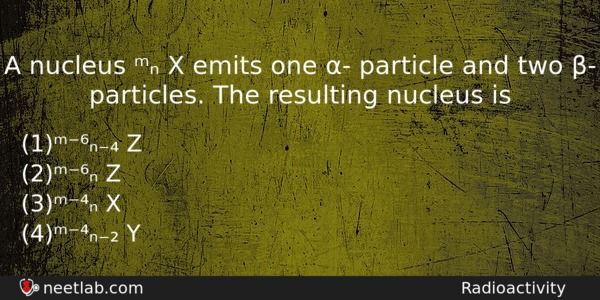| ⇦ | 
| ⇨ |
A nucleus ᵐₙ X emits one α- particle and two β- particles. The resulting nucleus is
Options
(a) ᵐ⁻⁶ₙ₋₄ Z
(b) ᵐ⁻⁶ₙ Z
(c) ᵐ⁻⁴ₙ X
(d) ᵐ⁻⁴ₙ₋₂ Y
Correct Answer:
ᵐ⁻⁴ₙ X
Explanation:
When ᵐₙ X emits one α- particle then its atomic mass decreases by 4 units and atomic number4 by 2. Therefore, the new nucleus becomes ᵐ⁻⁴ₙ₋₂ Y. But as it emits two β⁻ particles, its atomic number incre4ases by 2. Thus the resulting nucleus is ᵐ⁻⁴ₙ X.
Related Questions: - If white light is used in Young’s double slit experiment
- A bar magnet of moment of inertia I is vibrated in a magnetic field of induction
- The refractive index of water, glass and diamond are 1.33, 1.50, 2.40 respectively
- A particle of mass m, charge Q and kinetic enery T enters a transverse
- The angle between the two vectors A = 3i+4j+5k and B = 3i+4j-5k will be
Topics: Radioactivity
(83)
Subject: Physics
(2479)
Important MCQs Based on Medical Entrance Examinations To Improve Your NEET Score
- If white light is used in Young’s double slit experiment
- A bar magnet of moment of inertia I is vibrated in a magnetic field of induction
- The refractive index of water, glass and diamond are 1.33, 1.50, 2.40 respectively
- A particle of mass m, charge Q and kinetic enery T enters a transverse
- The angle between the two vectors A = 3i+4j+5k and B = 3i+4j-5k will be
Topics: Radioactivity (83)
Subject: Physics (2479)
Important MCQs Based on Medical Entrance Examinations To Improve Your NEET Score
18000+ students are using NEETLab to improve their score. What about you?
Solve Previous Year MCQs, Mock Tests, Topicwise Practice Tests, Identify Weak Topics, Formula Flash cards and much more is available in NEETLab Android App to improve your NEET score.
Share this page with your friends

Leave a Reply